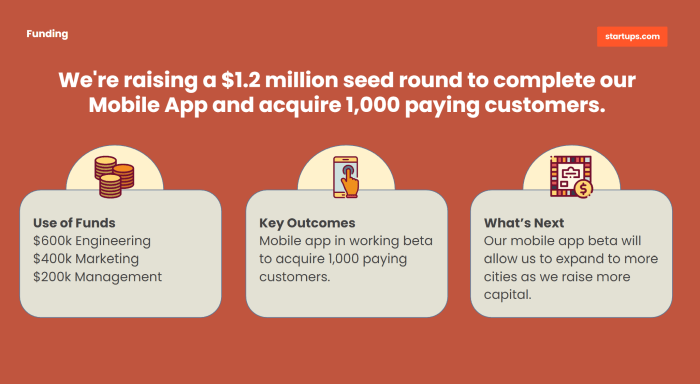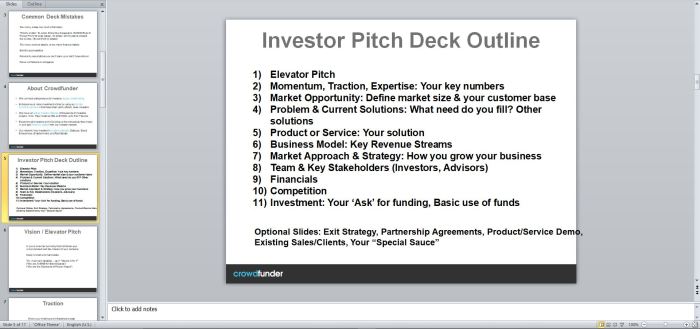
In the fast-paced world of startups, securing funding is crucial. This guide on Startup funding pitch deck tips offers valuable insights and strategies to help entrepreneurs create compelling pitches that captivate investors.
From outlining key elements to crafting a compelling narrative, this comprehensive overview covers all the essentials for a successful funding pitch.
STARTUP FUNDING

Securing funding is crucial for startups as it provides the necessary capital to develop products, scale operations, and enter the market successfully. Without adequate funding, startups may struggle to survive and grow in a competitive business environment.
Sources of Startup Funding
There are several sources of funding available for startups, including:
- Venture Capital: Investment firms that provide funding in exchange for equity ownership.
- Angel Investors: Individuals who invest their own capital in startups in exchange for equity or convertible debt.
- Crowdfunding: Platforms that allow startups to raise funds from a large number of individuals online.
- Accelerators and Incubators: Programs that provide funding, mentorship, and resources to startups in exchange for equity.
- Bank Loans: Traditional loans from financial institutions that startups can use to fund their operations.
Challenges in Startup Funding
Startups often face challenges when seeking funding, such as:
- Lack of Track Record: Investors may be hesitant to fund startups without a proven track record of success.
- Market Competition: Securing funding can be difficult in competitive markets with numerous startups vying for investor attention.
- Valuation Concerns: Startups and investors may struggle to agree on the valuation of the company, leading to challenges in securing funding.
- Risk Aversion: Investors may be risk-averse and hesitant to invest in early-stage startups with uncertain prospects.
Startup Funding Pitch Deck Tips
When creating a pitch deck for startup funding, it is crucial to include key elements that will capture the attention of potential investors. A well-crafted pitch deck can make a lasting impression and increase the chances of securing the necessary funding for your startup.
Key Elements of a Startup Pitch Deck
- Problem Statement: Clearly define the problem your startup aims to solve.
- Solution: Present your unique solution and how it addresses the identified problem.
- Market Opportunity: Showcase the market size, potential growth, and target audience for your product or service.
- Business Model: Explain how your startup will generate revenue and sustain growth.
- Team: Highlight the expertise and experience of your team members.
- Traction: Demonstrate any progress, milestones, or partnerships achieved by your startup.
- Financial Projections: Provide realistic and data-driven financial projections to support your business plan.
Importance of a Compelling Story in a Pitch Deck
Telling a compelling story in your pitch deck can engage investors on an emotional level and help them connect with your vision. A well-crafted narrative can make your startup stand out from the competition and leave a lasting impression on potential investors. It is essential to convey your passion, mission, and the impact of your startup in a way that resonates with the audience.
Optimal Length and Structure of a Pitch Deck
- Keep it concise: Aim for a pitch deck that is no more than 15-20 slides to maintain the interest of investors.
- Clear structure: Organize your pitch deck into sections that flow logically, such as problem-solution, market opportunity, business model, team, traction, and financials.
- Visual appeal: Use visuals, graphics, and charts to enhance the presentation and make complex information more digestible.
- Practice and refine: Rehearse your pitch deck multiple times to ensure smooth delivery and make any necessary adjustments based on feedback.
Crafting a Compelling Narrative
Creating a compelling narrative for your startup funding pitch is crucial to capturing the attention of potential investors and getting them excited about your vision. By crafting a story that resonates with them on an emotional level, you can make a lasting impression and stand out from the competition.When telling your startup’s story, it’s important to focus on the mission and vision behind your company.
Share why you started the business, what problem you are solving, and how your solution will make a positive impact. This narrative should be clear, concise, and easy for investors to understand.
Incorporating Data and Statistics
Using data and statistics effectively in your pitch can help to validate your claims and build credibility with investors. Make sure to back up your narrative with relevant numbers and metrics that support your value proposition.
- Highlight key performance indicators (KPIs) that demonstrate your startup’s growth potential.
- Use case studies or customer testimonials to show real-world results and success stories.
- Visualize data through charts or graphs to make complex information more digestible for investors.
- Emphasize market research findings to showcase the demand for your product or service.
Visual Design and Layout

When it comes to designing a visually appealing pitch deck, simplicity is key. You want to ensure that your slides are clean, easy to read, and visually engaging. Use a consistent color scheme and font throughout the deck to maintain a professional look.
Use of Images, Charts, and Graphs
Incorporating images, charts, and graphs can help enhance your pitch deck and make complex information easier to understand. Visual aids can also help create a more engaging presentation that keeps your audience interested. Just be sure to use high-quality images and clear, easy-to-read charts and graphs.
- Images: Use relevant images that support your narrative and add visual interest to your slides. Avoid cluttering your slides with too many images, and make sure they are high resolution.
- Charts and Graphs: When presenting data, use charts and graphs to make the information more digestible. Choose the right type of chart or graph that best represents your data and keep it simple and easy to interpret.
Examples of Successful Pitch Deck Designs and Layouts
There are many successful pitch deck designs and layouts to draw inspiration from. Companies like Airbnb, Uber, and Buffer have created visually appealing pitch decks that helped them secure funding. These decks typically feature clean, minimalist designs, impactful images, and clear, concise content.
- Airbnb: Airbnb’s pitch deck used a simple layout with bold imagery to showcase their unique value proposition. They used a consistent color scheme and font throughout the deck to create a cohesive look.
- Uber: Uber’s pitch deck focused on telling a compelling story through a combination of images, charts, and graphs. They used visuals to illustrate their market opportunity and growth potential.
- Buffer: Buffer’s pitch deck utilized a clean, modern design with plenty of white space to keep the focus on the content. They incorporated images and visuals to break up text-heavy slides and maintain audience engagement.
Financial Projections and Data

When preparing a startup funding pitch deck, accurate financial projections play a crucial role in showcasing the potential growth and profitability of your business to potential investors. These projections help investors understand the financial health of your startup and assess the return on investment.
Presenting Financial Data Clearly
It is essential to present financial data in a clear and concise manner to ensure that investors can easily grasp the key numbers and trends. Here are some tips for presenting financial data effectively:
- Use visual aids such as charts, graphs, and tables to illustrate financial projections.
- Highlight key metrics and figures that are relevant to the growth and success of your startup.
- Provide explanations for any assumptions or variables used in your financial projections to add transparency.
- Ensure that the layout and design of your financial data are consistent with the overall look and feel of your pitch deck.
Addressing Potential Questions
During the pitch presentation, you may encounter questions from investors regarding your financial projections. It is essential to be prepared to address these questions confidently and transparently. Here’s how you can handle potential questions about financial projections:
- Be ready to explain the methodology and reasoning behind your financial projections to demonstrate a deep understanding of your business model.
- Anticipate questions about key assumptions, growth drivers, and potential risks that could impact your financial performance.
- Provide scenarios or sensitivity analysis to show how changes in certain variables could affect your financial projections.
- Stay open to feedback and be willing to adapt your financial projections based on investor input to build credibility and trust.
Mastering the art of pitch deck presentations is key to securing funding for your startup. By implementing the tips and strategies discussed, entrepreneurs can enhance their pitch decks and increase their chances of attracting potential investors.
Commonly Asked Questions
How important is storytelling in a startup pitch deck?
Storytelling plays a crucial role in engaging investors and conveying the mission and vision of the startup effectively.
What should be the ideal length of a pitch deck?
An optimal pitch deck is usually around 10-15 slides, keeping it concise and focused on key information.
How can financial projections be presented clearly in a pitch deck?
Financial data should be organized logically, using charts and graphs to visually represent projections for better understanding.





